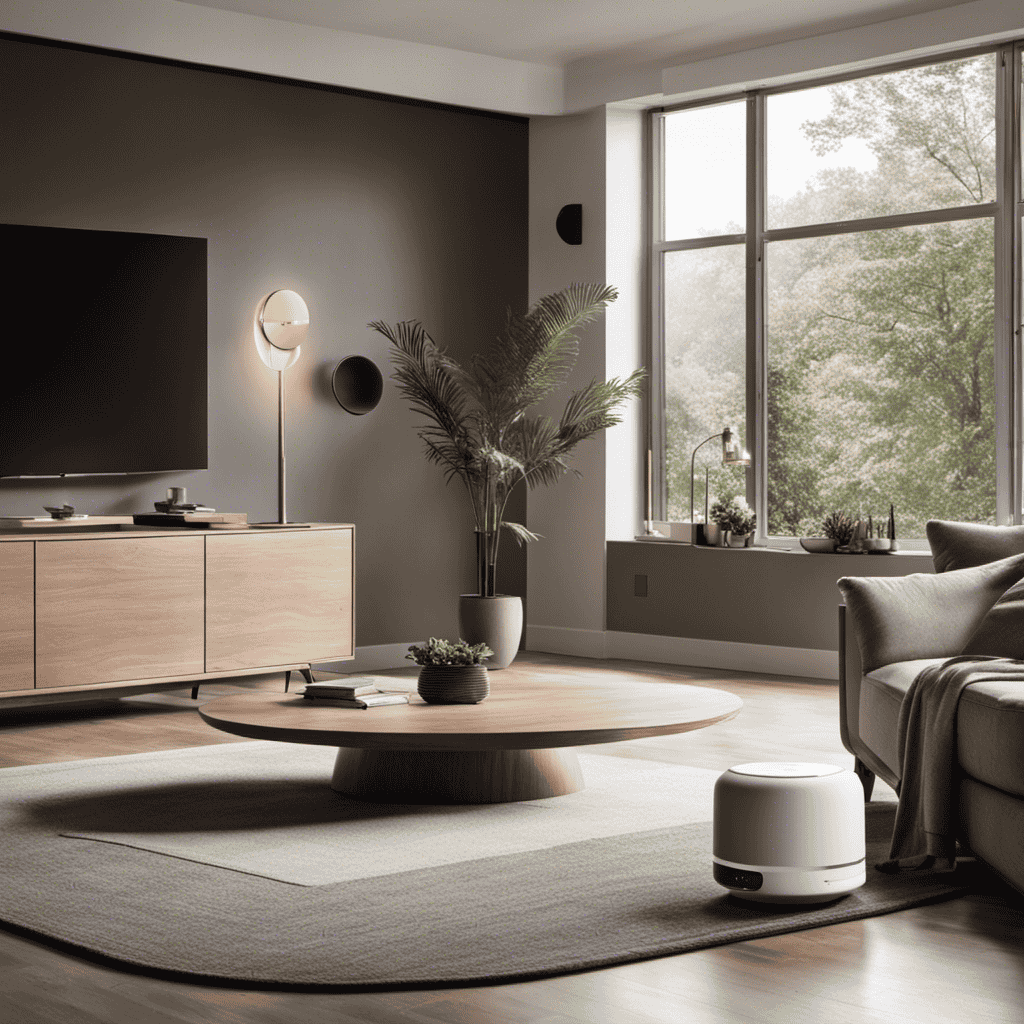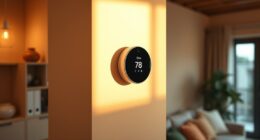I’ve always been worried about the air quality in my home, especially with my allergies. That’s why I decided to purchase a Coway air purifier. It has made a huge difference, but I soon learned that regular cleaning is crucial to keep it working efficiently.
If you’re like me and want to keep your air purifier in top shape, this article will guide you through the process step by step. Trust me, it’s easier than you think!
Key Takeaways
- Unplug the air purifier and turn off the unit before cleaning.
- Regularly clean and replace the filters for optimal performance.
- Use mild, non-abrasive cleaning products to clean the exterior of the air purifier.
- Monitor the air purifier’s performance and maintain good air circulation for effective filtration.
Understanding the Cleaning Process
Understanding the cleaning process is essential when it comes to maintaining a Coway air purifier. To ensure optimal performance and longevity of your purifier, it is important to follow the correct cleaning techniques.
Start by unplugging the purifier from the power source and turning off the unit. Remove the front cover and gently wipe it with a microfiber cloth to remove any accumulated dust or dirt.
For deeper cleaning, use a soft brush to clean the air inlet and outlet. If you encounter any issues during the cleaning process, such as a malfunctioning fan or unusual noises, refer to the troubleshooting tips provided in the user manual.
Once you have completed the cleaning process, you can proceed to gather the necessary supplies for the next step.
Gathering the Necessary Supplies
When it comes to cleaning, having the right tools is essential. From microfiber cloths to vacuum cleaners, these tools are designed to help you effectively remove dirt and grime.
Additionally, knowing the proper cleaning techniques is crucial to achieving a clean and sanitary environment. By understanding how to use these tools correctly, you can ensure that your cleaning efforts are efficient and thorough.
Essential Cleaning Tools
To effectively clean your Coway air purifier, you’ll need a few essential tools. Material compatibility is crucial when selecting cleaning products for your air purifier. It is recommended to use mild, non-abrasive cleaners that are safe for the materials used in the purifier.
Microfiber cloths are an excellent choice for wiping down the exterior surfaces as they are soft and won’t scratch the finish. Additionally, a small brush with soft bristles can be used to remove any dust or debris from the intake vents.
To ensure thorough cleaning, it is important to have access to the filter compartment. Most Coway air purifiers have removable filters that can be easily washed or replaced. Proper cleaning techniques will be discussed in the following section.
Proper Cleaning Techniques
Once you’ve gathered the essential cleaning tools, it’s important to follow proper techniques to ensure effective maintenance of your Coway air purifier. Understanding the benefits of proper cleaning techniques will help you keep your air purifier running efficiently. Here are some troubleshooting tips to ensure you’re cleaning your Coway air purifier correctly:
- Turn off the power and unplug the unit before cleaning.
- Remove the pre-filter and wash it with water.
- Use a soft brush or cloth to clean the dust sensor and the air quality indicator.
- Wipe the exterior of the air purifier with a damp cloth.
- Replace the filters regularly as recommended by the manufacturer.
Following these steps will help you maintain your Coway air purifier and ensure that it continues to provide clean and fresh air in your space.
Powering Off and Unplugging the Air Purifier
Make sure you’ve turned off and unplugged the air purifier before starting the cleaning process. To power off the Coway air purifier, simply press the power button located on the control panel. The power indicator light will turn off, indicating that the unit is no longer receiving power.
Once the air purifier is powered off, unplug it from the electrical outlet to ensure complete safety during the cleaning process.
When you’re ready to restart the air purifier, plug it back into the electrical outlet and press the power button again. The power indicator light will illuminate, indicating that the unit is now powered on and ready to use.
If you encounter any issues with the power or restarting process, such as the unit not powering on or the power indicator light not illuminating, refer to the troubleshooting section in the user manual. It provides solutions to common issues and can help resolve any problems you may encounter.
Removing and Cleaning the Pre-Filter
Now that we have powered off and unplugged the Coway Air Purifier, it’s time to move on to the next step: removing and cleaning the pre-filter. Understanding pre-filter maintenance is crucial for keeping your air purifier working efficiently.
Here are some troubleshooting tips for pre-filter issues:
- Begin by locating the pre-filter compartment, usually located at the front or back of the unit.
- Gently open the compartment using the designated latch or button.
- Carefully remove the pre-filter from its housing, taking note of its position for easy reassembly.
- Rinse the pre-filter under lukewarm water to remove dust and debris.
- Allow the pre-filter to air dry completely before placing it back into the air purifier.
Regularly cleaning the pre-filter will improve the overall performance of your Coway Air Purifier and ensure cleaner air in your home.
Cleaning the Carbon Filter
To clean the carbon filter, you’ll need to locate the carbon filter compartment on your device. Carbon filters are an essential component of air purifiers as they help remove odors, chemicals, and volatile organic compounds (VOCs) from the air. Understanding carbon filtration is crucial in maintaining the effectiveness of your air purifier.
Cleaning the carbon filter regularly can help prolong its lifespan and ensure that it continues to function optimally.
Here is a simple step-by-step guide to clean the carbon filter:
- Turn off and unplug the air purifier.
- Remove the carbon filter compartment cover.
- Take out the carbon filter and gently tap it to remove any loose particles.
- Rinse the carbon filter under running water to remove stubborn dirt and debris.
- Allow the filter to air dry completely before placing it back into the compartment.
- Replace the carbon filter compartment cover and plug in the air purifier.
Washing or Replacing the HEPA Filter
When it comes to filter maintenance, I have found a few key tips to be extremely helpful.
First, it’s important to regularly clean or replace your filters to ensure optimal performance.
Second, make sure to follow the manufacturer’s instructions for proper maintenance and care.
Lastly, it’s essential to weigh the pros and cons of different filter types, such as HEPA filters, to determine which option is best suited for your specific needs and preferences.
Filter Maintenance Tips
Regularly replacing the filters is essential for maintaining the effectiveness of your Coway air purifier. Here are some filter maintenance tips to ensure optimal performance:
- Check the filter indicator light regularly to know when it’s time to replace the filters.
- Use genuine Coway replacement filters to ensure compatibility and effectiveness.
- Clean the pre-filter every two weeks to remove larger particles and prolong the life of the main filters.
- Vacuum the outer surface of the HEPA filter gently to remove dust and debris.
- If you notice a decrease in airflow or performance, try resetting the air purifier by unplugging it for a few minutes.
By following these filter maintenance tips, you can keep your Coway air purifier running smoothly and efficiently.
Now let’s explore the pros and cons of using a Coway air purifier.
Pros and Cons
You’ll want to consider the pros and cons of using a Coway air purifier before making a decision.
The pros of using a Coway air purifier include its high-efficiency particulate air (HEPA) filtration system, which can effectively remove airborne pollutants such as dust, allergens, and pet dander. It also has a sleek design and operates quietly, making it suitable for any room in your home. Additionally, Coway air purifiers have a smart sensor that detects the air quality and adjusts the fan speed accordingly.
However, there are a few cons to consider. The replacement filters can be quite expensive, and some users have reported issues with the sensor accuracy. Troubleshooting tips for these issues include cleaning the sensor or contacting customer support for assistance.
Overall, the Coway air purifier offers many benefits, but it’s important to weigh the pros and cons before purchasing.
Cleaning the Sensor and Indicator Lights
To clean the sensor and indicator lights on your Coway air purifier, gently wipe them with a soft cloth. It’s important to keep these components clean to ensure optimal performance and accurate readings.
Here are some tips for maintaining the sensor and indicator lights:
- Use a microfiber cloth to avoid scratching the surface.
- Avoid using harsh chemicals or abrasive cleaners that could damage the sensors.
- Clean the sensor and lights regularly to prevent dust and dirt buildup.
- If the indicator lights are not functioning properly, check the power source and connections.
- If the sensor readings are inconsistent, try resetting the air purifier or contacting customer support for further assistance.
By properly cleaning the sensor and indicator lights, you can ensure that your Coway air purifier continues to operate efficiently.
Now, let’s move on to cleaning the exterior of the air purifier.
Cleaning the Exterior of the Air Purifier
When it comes to cleaning the exterior of your air purifier, it is important to consider the material compatibility for cleaning. Different materials may require different cleaning methods and products to avoid damage or discoloration.
It is recommended to use mild, non-abrasive cleaning products that are suitable for the specific materials of your air purifier.
Additionally, the frequency of exterior cleaning will depend on factors such as the environment it is placed in and the amount of dust and dirt it accumulates. However, a general guideline is to clean it at least once every few weeks to maintain its appearance and performance.
Material Compatibility for Cleaning
Make sure the cleaning products you use are compatible with the materials of your Coway air purifier. Using the wrong cleaning solutions can damage the delicate components of your air purifier and reduce its performance.
To keep your Coway air purifier in top condition, follow these guidelines:
- Read the user manual: Familiarize yourself with the recommended cleaning solutions for your specific model.
- Use mild, non-abrasive cleaners: Avoid harsh chemicals or abrasive cleaners that can scratch or damage the surface of the air purifier.
- Avoid excessive moisture: Use a damp cloth or sponge to clean the exterior, but make sure it is not dripping wet.
- Clean the filters regularly: Follow the manufacturer’s instructions for cleaning and replacing the filters on a regular schedule.
- Consider professional cleaning: If you are unsure about cleaning your Coway air purifier, contact a professional technician who can safely clean and maintain your device.
Following these cleaning guidelines will help ensure the longevity and optimal performance of your Coway air purifier.
Recommended Cleaning Products
Now that we understand the importance of material compatibility when cleaning a Coway air purifier, let’s discuss the recommended cleaning techniques and alternative cleaning solutions.
To ensure effective cleaning without damaging the device, it is recommended to use a soft, lint-free cloth or a microfiber cloth for wiping the exterior surfaces. Avoid using abrasive cleaners or harsh chemicals as they may cause discoloration or damage to the unit.
For the filters, it is best to follow the manufacturer’s instructions for cleaning or replacing them. However, if you are looking for alternative cleaning solutions, you can consider using a mixture of mild soap and water to gently clean the filters. Just make sure to rinse them thoroughly and allow them to dry completely before reinserting them into the air purifier.
Frequency of Exterior Cleaning
To maintain the performance of your device, it’s important to regularly wipe down the exterior surfaces with a soft cloth. Here are some guidelines for determining the frequency of exterior cleaning:
- Evaluate the environment: Consider factors such as dust levels, pet presence, and air pollution in your area.
- Follow the manufacturer’s recommendations: Check the user manual for specific guidelines on cleaning schedules.
- Monitor visible dirt and dust: If you notice a buildup of particles on the exterior, it’s time for a cleaning.
- Schedule regular cleanings: Set a routine for wiping down the surfaces every few weeks or months, depending on your needs.
- Prioritize cleanliness during flu seasons or allergy peaks: During times when airborne contaminants are more prevalent, increase the frequency of cleaning.
By maintaining a regular exterior cleaning schedule, you can ensure that your Coway air purifier remains in top condition.
Now, let’s move on to cleaning the air quality monitor.
Cleaning the Air Quality Monitor
You can start by removing the air quality monitor from the Coway air purifier. Understanding air pollution and the benefits of air purifiers is crucial when it comes to maintaining clean and healthy indoor air.
The air quality monitor plays a vital role in ensuring that your air purifier is working efficiently. To clean the air quality monitor, gently wipe it with a soft, lint-free cloth. Avoid using any harsh chemicals or abrasive materials that could damage the monitor.
It’s important to regularly clean the air quality monitor to ensure accurate readings and optimal performance. By keeping the monitor clean, you can effectively monitor and improve the air quality in your home, providing you with a healthier living environment.
Reassembling the Air Purifier
After reassembling the parts, make sure all the components are securely in place. This is a crucial step in the reassembling process of your Coway air purifier.
To ensure the proper functioning of your device, here are some troubleshooting tips:
- Check for any loose connections or wires.
- Verify that the filters are correctly positioned and tightly sealed.
- Inspect the fan and motor assembly for any obstructions or damage.
- Ensure that the control panel is securely attached and aligned.
- Test the power supply and make sure it is properly connected.
By following these troubleshooting tips, you can avoid potential issues and ensure optimal performance of your Coway air purifier.
Remember to refer to the user manual for detailed instructions on the reassembling process and troubleshooting specific to your model.
Is the Cleaning Process Similar for Different Brands of Air Purifiers?
When it comes to cleaning your Holmes air purifier, the process is generally similar across different brands. Following a clean Holmes air purifier tutorial can help you effectively remove dust, dirt, and other particles from the device, improving its performance and lifespan. Regular cleaning is essential for optimal air purification.
Maintaining and Regularly Cleaning the Air Purifier
Now that we have learned how to reassemble the Coway air purifier, let’s move on to the important task of maintaining and regularly cleaning the device. It is essential to understand filter effectiveness and troubleshoot common issues to ensure the air purifier functions optimally.
To maintain the air purifier, follow these steps:
-
Cleaning the Pre-Filter: Remove the pre-filter and gently vacuum or wash it with water. Allow it to dry completely before reinstalling.
-
Replacing the Filters: Refer to the user manual for filter replacement intervals. Regularly replace the HEPA and activated carbon filters to maintain optimal performance.
-
Cleaning the Exterior: Wipe the exterior of the air purifier with a damp cloth. Avoid using harsh chemicals or abrasive materials.
-
Monitoring Filter Life: Keep track of the filter life indicator on the device to know when it’s time to replace the filters.
Frequently Asked Questions
Can I Use Soap and Water to Clean the Pre-Filter?
Yes, soap and water can be used to clean the pre-filter of a Coway Air Purifier. However, it is important to follow the manufacturer’s instructions and consider using disinfectant wipes for optimal cleaning.
How Often Should I Replace the HEPA Filter?
I should replace the HEPA filter in my Coway Air Purifier every 12 months. Signs that indicate the HEPA filter needs replacement include reduced air flow and a decrease in the purifier’s effectiveness.
Can I Use a Vacuum Cleaner to Clean the Exterior of the Air Purifier?
Certainly! Instead of a vacuum cleaner, I recommend using a blower to clean the exterior of the air purifier. To clean the interior, follow these steps: [insert steps for cleaning the interior].
Is It Safe to Clean the Sensor and Indicator Lights With a Wet Cloth?
It’s not safe to clean the sensor and indicator lights with a wet cloth. Instead, use a dry cloth or compressed air to remove dust. Refer to the user manual for the best practices and troubleshooting tips.
What Should I Do if the Air Quality Monitor Is Not Working Properly After Cleaning?
If the air quality monitor is not working properly after cleaning, I would troubleshoot the sensor malfunction. I would follow the manufacturer’s instructions to check for any loose connections or debris that may be affecting its functionality.
Conclusion
In conclusion, cleaning a Coway air purifier is a simple yet important task. It ensures optimal performance and clean air in your space. By following the step-by-step process, gathering the necessary supplies, and taking the time to clean each component thoroughly, you can maintain the longevity and efficiency of your air purifier.
Remember, while the cleaning process may seem technical and precise, it’s also an opportunity to show some love to your trusty purifier. It makes it a breath of fresh air in your home.










